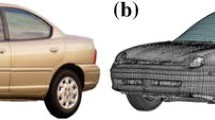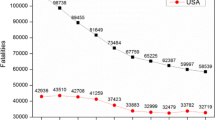Abstract
This paper presents a crashworthiness design optimization method based on a metamodeling technique. The crashworthiness optimization is a highly nonlinear and large scale problem, which is composed various nonlinearities, such as geometry, material and contact and needs a large number expensive evaluations. In order to obtain a robust approximation efficiently, a probability-based least square support vector regression is suggested to construct metamodels by considering structure risk minimization. Further, to save the computational cost, an intelligent sampling strategy is applied to generate sample points at the stage of design of experiment (DOE). In this paper, a cylinder, a full vehicle frontal collision is involved. The results demonstrate that the proposed metamodel-based optimization is efficient and effective in solving crashworthiness, design optimization problems.
Similar content being viewed by others
Abbreviations
- AIMS:
-
Adaptive and interactive modeling system
- BBNS:
-
Boundary and best neighbor sampling
- D-OPT:
-
D-optimum
- DOE:
-
Design of experiment
- ERM:
-
Empirical risk minimization
- FE:
-
Finite element
- FF:
-
Full factorial
- KKT:
-
Karush–Kuhn–Tucker
- LHS:
-
Latin hypercube sampling
- LS-SVR:
-
Least square support vector regression
- PR-RSM:
-
Polynomial regression response surface methodology
- PSO:
-
Particle swarm optimization
- RBF:
-
Radial basis function
- PLS-SVR:
-
Probability-based least square support vector regression
- SM:
-
Space mapping
- SVR:
-
Support vector regression
- SSE:
-
Sum-squared error
- SRM:
-
Structure risk minimization
References
Kurtaran H, Eskandarian A, Marzougui D, Bedewi NE (2002) Crashworthiness design optimization using successive response surface approximations. Comput Mech 29(4–5): 409–421
Yang RJ, Wang N, Tho CH, Bobineau JP (2001) Metamodelling development for vehicle frontal impact simulation. In: Proceedings of ASME design engineering technical conferences, Pittsburgh, PA, September 2001
Yang RJ, Wang N, Tho CH, Bobineau JP, Wang BP (2005) Metamodeling development for vehicle frontal impact simulation. J Mech Des 127(5): 1014–1021
Forsberg J, Nilsson L (2005) On polynomial response surfaces and Kriging for use in structural optimization of crashworthiness. Struct Multidiscip Optim 29(3): 232–243
Redhe M, Forsberg J, Jansson T, Marklund PO, Nilsson L (2002) Using the response surface methodology and the D-optimality criterion in crashworthiness related problems. Struct Multidiscip Optim 24: 185–194
Fang H, Rais-Rohani M, Liu Z, Horstemeyer MF (2005) A comparative study of metamodeling methods for multiobjective crashworthiness optimization. Comput Struct 83: 2121–2136
Wang H, Li E, Li GY, Zhong ZH (2008) Development of metamodeling based optimization system for high nonlinear engineering problems. Adv Eng Softw 39(8): 629–645
Redhe M, Nilsson LA (2006) Multipoint version of space mapping optimization applied to vehicle crashworthiness design. Struct Multidisc Opt 31(2): 134–146
Fang H, Rais-Rohani M, Liu Z, Horstemeyer MF (2005) A comparative study of metamodeling methods for multiobjective crashworthiness optimization. Comput Struct 83(25–26): 2121–2136
Yang H, Chan L, King I et al (2002) Support vector machine regression for volatile stock market prediction. In: Yin H (eds) IDEAL, Lecture notes in Computer Science, vol 2412. Springer, Berlin, pp 391–396
Yang H, King I, Chan L (2002) Non-fixed and asymmetrical margin approach to stock market prediction using support vector regression. In: Proceedings of the international conference on neural information processing (ICONIP2002), Singapore
Wu CH, Ho MJ, Lee DT (2003) Travel time prediction with support vector regression. IEEE Trans Intell Transport Syst 5: 276–281
Cherkassky V, Ma Y (2004) Comparison of loss functions for linear regression. In: Proceedings of the 2004 IEEE international joint conference on neural networks 1(25–29):400–405
Suykens JAK, Vandewalle J (1999) Least squares support vector machine classifiers. Neural Process Lett 9(3): 293–300
Box GEP, Draper NR (1969) Evolutionary operation: a statistical method for process management. Wiley, New York
Chen W, Allen JK, Schrage DP, Mistree F (1997) Statistical experimentation methods for achieving affordable concurrent systems design. AIAA J 35(5): 893–900
Wujek BA, Renaud JE (1998) New adaptive move-limit management strategy for approximate optimization. Part 1. AIAA J 36(10): 1911–1921
Wujek BA, Renaud JE (1998) New adaptive move-limit management strategy for approximate optimization. Part 2. AIAA J 36(10): 1922–1934
Toropov V, van Keulen F, Markine V, de Doer H (1996) Refinements in the multi-Point approximation method to reduce the effects of noisy structural responses. In: Proceedings 6th AIAA/USAF/NASA/ISSMO symposium on multidisciplinary analysis and optimization, vol 2, AIAA, Bellevue, WA, 4–6 September, AIAA-96-4087-CP
Alexandrov N, Dennis JEJ, Lewis RM, Torczon V (1998) A trust region framework for managing the use of approximation models in optimization. Struct Optim 15(1): 16–23
Wang GG, Dong Z, Aitchison P (2001) Adaptive response surface method—a global optimization scheme for computation-intensive design problems. Eng Optim 33(6): 707–734
Wang H, Li GY, Zhong ZH (2008) Optimization of sheet metal forming processes by adaptive response surface based on intelligent sampling method. J Mater Process Technol 197(1–3): 77–88
Jianqing F, Yao Q (2003) Nonlinear time series: nonparametric and parametric methods. Springer, New York
Li Q, Racine JS (2007) Nonparametric econometrics: theory and practice. Princeton University Press, Princeton
Jin R, Chen W, Simpson TW (2001) Comparative studies of metamodeling techniques under multiple modeling criteria. Struct Multidiscip Optim 23(1): 1–13
Author information
Authors and Affiliations
Corresponding authors
Rights and permissions
About this article
Cite this article
Wang, H., Li, E. & Li, G.Y. Probability-based least square support vector regression metamodeling technique for crashworthiness optimization problems. Comput Mech 47, 251–263 (2011). https://doi.org/10.1007/s00466-010-0532-y
Received:
Accepted:
Published:
Issue Date:
DOI: https://doi.org/10.1007/s00466-010-0532-y




